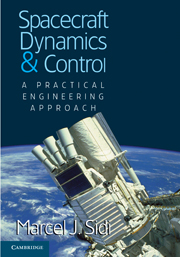Book contents
- Frontmatter
- Dedication
- Contents
- Preface
- Acknowledgments
- Chapter 1 Introduction
- Chapter 2 Orbit Dynamics
- Chapter 3 Orbital Maneuvers
- Chapter 4 Attitude Dynamics and Kinematics
- Chapter 5 Gravity Gradient Stabilization
- Chapter 6 Single- and Dual-Spin Stabilization
- Chapter 7 Attitude Maneuvers in Space
- Chapter 8 Momentum-Biased Attitude Stabilization
- Chapter 9 Reaction Thruster Attitude Control
- Chapter 10 Structural Dynamics and Liquid Sloshing
- Appendix A Attitude Transformations in Space
- Appendix B Attitude Determination Hardware
- Appendix C Orbit and Attitude Control Hardware
- Index
- References
Chapter 10 - Structural Dynamics and Liquid Sloshing
Published online by Cambridge University Press: 18 December 2014
- Frontmatter
- Dedication
- Contents
- Preface
- Acknowledgments
- Chapter 1 Introduction
- Chapter 2 Orbit Dynamics
- Chapter 3 Orbital Maneuvers
- Chapter 4 Attitude Dynamics and Kinematics
- Chapter 5 Gravity Gradient Stabilization
- Chapter 6 Single- and Dual-Spin Stabilization
- Chapter 7 Attitude Maneuvers in Space
- Chapter 8 Momentum-Biased Attitude Stabilization
- Chapter 9 Reaction Thruster Attitude Control
- Chapter 10 Structural Dynamics and Liquid Sloshing
- Appendix A Attitude Transformations in Space
- Appendix B Attitude Determination Hardware
- Appendix C Orbit and Attitude Control Hardware
- Index
- References
Summary
Introduction
A typical spacecraft structure consists of two principal parts. The first one is the body of the spacecraft, which contains all the payload instrumentation and control hardware pertaining to the Attitude and Orbit Control System (AOCS). Its structure must be very rigid in order to withstand mechanical loads during the launch stage, and also to assure correct positioning of the control torquers and attitude sensors for achieving the necessary pointing accuracy in the s/c mission stage. The necessity to save on weight leads to mechanical design tradeoffs between weight and rigidity, which results in a body that is only quasirigid and in which structural vibration modes should be anticipated.
The second part of the spacecraft structure consists of large flexible appendages: parabolic antennae, large synthetic-aperture radar, and very large flexible solar arrays built from light materials in order to reduce their weight. Spacecraft structures are now. becoming extremely complicated because of these appendages, which also induce structural oscillation under the excitation of external torques and forces. Finally, we must likewise consider vibrations due to the liquid contained in fuel tanks. The vibrational dynamics evolving from flexible appendages and liquid sloshing interferes strongly with the attitude control dynamics, and puts severe limitations on the achievable qualities of the attitude control system (ACS).
This chapter is primarily concerned with this second class of structural vibrations. First, we must write simplified structural dynamics models for solar panels and liquid sloshing before coupling them to the rigid-body attitude dynamics of spacecraft. An analytical model for the rigid body and the flexible structural modes will allow us to evaluate the limitations on the bandwidth of the ACS.
Modeling Solar Panels
Although the techniques of structural modeling described in this chapter are applicable to any nonrigid appendage to the solid body, we will concentrate on the structural dynamics of solar panels, which are common to almost all types of satellites.
Information
- Type
- Chapter
- Information
- Spacecraft Dynamics and ControlA Practical Engineering Approach, pp. 291 - 317Publisher: Cambridge University PressPrint publication year: 1997
References
Accessibility standard: Unknown
Why this information is here
This section outlines the accessibility features of this content - including support for screen readers, full keyboard navigation and high-contrast display options. This may not be relevant for you.Accessibility Information
- 5
- Cited by
